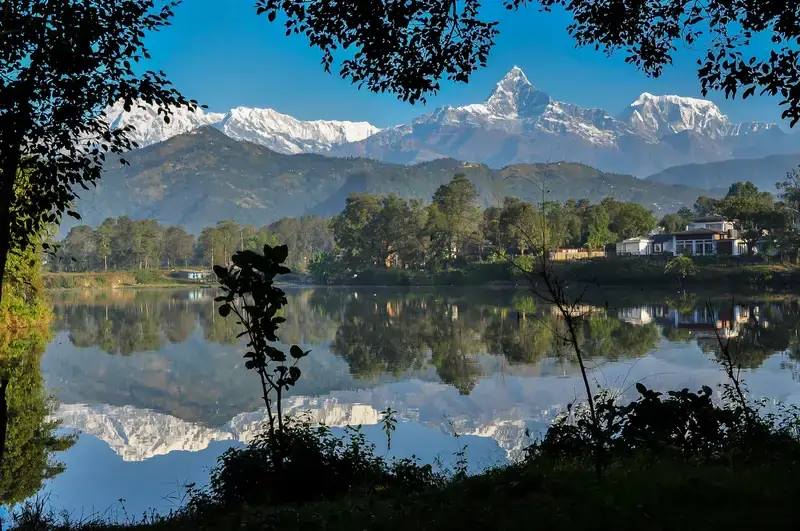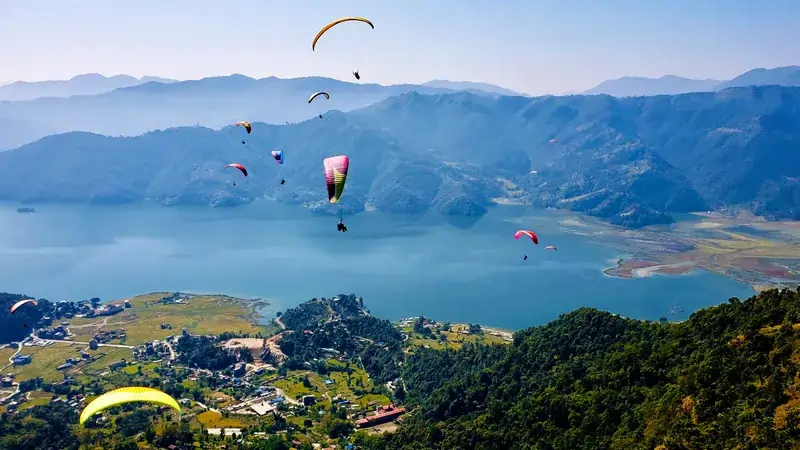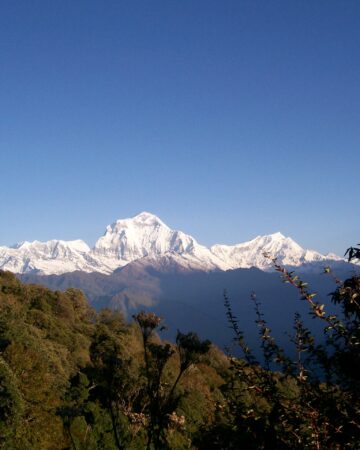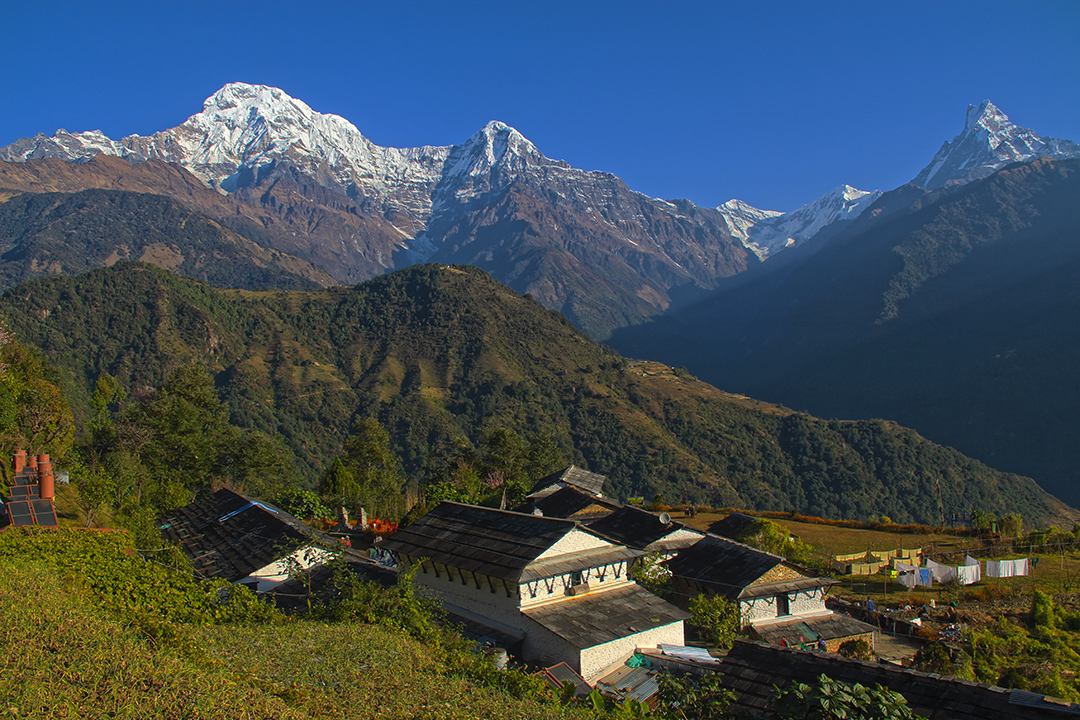Overview
Combining trekking with yoga in the beautiful landscapes of Neudanda, Netherlands Camp, and Australian Camp can create an incredibly rejuvenating experience. The serene surroundings, coupled with the physical activity of trekking, offer an excellent opportunity to immerse yourself in both nature and yoga practice.
Yoga trekking involves incorporating yoga sessions into your trekking itinerary, allowing you to stretch, relax, and connect with your body amidst the stunning natural settings.
Blending trekking with yoga can offer a holistic experience, combining physical activity, mental relaxation, and a deeper connection with nature. Embrace the journey and the tranquility that these beautiful locations offer!
Highlight of Annapurna Panorama Yoga Trek
- Yoga Sessions: Plan yoga sessions during your trek, perhaps in the mornings or evenings at serene spots along the trail or at your overnight stops. Engage in meditation, stretching, and breathing exercises to energize and unwind.
- Mindful Trekking: Practice mindfulness while trekking. Enjoy the beauty of the landscapes, breathe in the fresh air, and connect with nature as you move through the trails. Use moments during breaks or stops to perform yoga poses that can help ease muscle tension from trekking.
- Professional Guidance: Consider hiring a yoga instructor or guide who specializes in combining yoga with trekking. They can lead dedicated yoga sessions and provide guidance on the best practices to incorporate yoga into your trek.
- Appreciate the Moments: Use the stunning vistas of Neudanda, Netherlands Camp, and Australian Camp as your backdrop for yoga and take the time to appreciate the beauty around you.
Itinerary
Includes/Excludes
Cost Includes
- Pick up from Airport on Arrival Day
- 2 Nights accommodation in Kathmandu in 3 Stars Hotel in Twin Sharing basis
- Private vehicle to Pokhara & from Pokhara to Kande to start trip
- 2 Nights Accommodation in Pokhara in 3 stars Hotel in Twin Sharing basis
- Trekkers lodge/ Guest House accommodation in mountain in Twin Sharing basis
- Daily Breakfast. Lunch & Dinner
- Annapurna Conservation Entry Permit
- TIMS Trekking Permit
- Yoga cum Trekking guide
- Assistants( Porters) to carry your belonging( One Porter Between two members)
- Private Vehicle to Return Pokhara from Siding
- Private Vehicle to Kathmandu
- Trip cost Excludes
Trip cost Excludes
- Personal Nature Expenses
- Travel Medical Insurance
- Bar Bill
- TIPS to trekking crews
Yoga Sessions:
Daily Yoga Practice: Set aside dedicated time each day for yoga sessions. Choose serene spots along the trail or at resting points to practice yoga, meditation, and breathing exercises.
Nature Appreciation & Mindfulness:
Mindful Trekking: Practice mindfulness while trekking. Be present in the moment, observe nature, and focus on your surroundings.
Nature Walks: Take short walks or detours to explore nearby natural attractions, such as waterfalls, viewpoints, or serene spots conducive to meditation.
Cultural Exploration:
Interact with Locals: Engage with locals you encounter along the way, learn about their culture, and perhaps join in local activities or rituals if the opportunity arises.
Cultural Performances: Some trekking lodges or villages may host cultural performances or demonstrations. Participate and immerse yourself in the local traditions.
Relaxation & Recreation:
Rest & Rejuvenate: Take breaks during the trek to rest, relax, and rejuvenate. Enjoy the tranquility of the surroundings.
Spa & Wellness: In some accommodations, you might find options for spa treatments or wellness facilities. Treat yourself to massages or other relaxing activities.
Nature Immersion:
Birdwatching & Wildlife Observation: Nepal’s landscapes are rich in biodiversity. Spend time observing birds and wildlife if the opportunity arises.
Photography: Capture the stunning landscapes, cultural elements, and serene moments during your trek.
Other Physical Activities:
Hiking Extensions: Consider side trips or extensions to nearby attractions or viewpoints for added physical activity and exploration.
Short Exercise Sessions: Besides yoga, engage in brief exercises or stretches to keep your body active and flexible.
Group Activities:
Group Meditation or Yoga: If trekking with a group, organize group meditation or yoga sessions to share the experience with fellow trekkers.
Sharing Circles: Engage in group discussions or sharing circles where participants can reflect on their experiences during the trek.
Accommodation:Accommodation along the Annapuran Panorama Yoga trekking route primarily consists of teahouses, lodges, and guesthouses that cater to trekkers’ needs. These accommodations are basic but provide necessary amenities for a comfortable stay during the trek.
Teahouses: Often found in smaller villages along the trail, teahouses offer simple rooms with shared facilities such as bathrooms. They provide meals and beverages, including tea and snacks, and offer a cozy atmosphere for trekkers to rest.
Lodges/Guesthouses: As you ascend higher or reach larger settlements, you’ll find more substantial lodges or guesthouses. These places often have private rooms with attached or shared bathrooms, providing slightly more comfort than teahouses. They also offer meals, sometimes with more varied menu options.
The accommodation options may vary in terms of comfort and facilities, but all aim to provide trekkers with a warm place to rest, dine, and rejuvenate after a day of trekking. It’s recommended to be flexible and adaptable as you may encounter different standards of accommodation along the route. Booking in advance during peak trekking seasons can also be beneficial to secure a spot, especially in more popular areas.
Food & Drinks
Meals:
Local Cuisine: Teahouses and lodges typically serve Nepali cuisine, including dal bhat (rice and lentil soup), momos (dumplings), noodles, and curries. These meals are often hearty and provide the necessary energy for trekking.
Western Options: In more established lodges, you might find a selection of Western dishes such as pasta, pancakes, sandwiches, and pizzas, catering to different tastes.
Vegetarian Options: There are usually plenty of vegetarian choices available, reflecting the local diet that often emphasizes vegetarian dishes.
Beverages:
Tea and Coffee: Hot beverages like masala chai (spiced tea) and coffee are commonly available and are great for warming up during colder treks.
Soft Drinks: Some places might offer soft drinks and packaged beverages, though availability can be limited and prices higher due to transportation difficulties in these remote areas.
The food is generally prepared fresh, but since the trekking region is remote, the variety of ingredients might be limited. It’s wise to avoid overly complicated or rich dishes that might strain the local resources. Additionally, carrying some energy bars, snacks, or water purification tools can be beneficial during the trek, especially for longer and more challenging segments of the trail.
Trekking Permits:
TIMS Card (Trekkers’ Information Management System): This card is typically required for most treks in Nepal. It’s meant to keep track of trekkers and ensure their safety. You can obtain this card through the authorized agencies. Adventure Speed (P) Ltd is an authorized agency to issue permit
Annapurna Conservation Area Permit (ACAP): Since the Mardi Himal Trek falls within the Annapurna Conservation Area, an ACAP permit is necessary. You can obtain this card through the authorized agencies. Adventure Speed (P) Ltd is an authorized agency to issue permit
Safe Drinking Water:
In the Mardi Himal trekking region, ensuring safe drinking water is crucial to avoid waterborne illnesses. Here are some ways to ensure you have access to safe drinking water:
Boiled Water: One of the safest methods is to drink boiled water. Most teahouses and lodges along the trail offer boiled water for a small fee. They use filtered or treated water, which is then boiled to make it safe for consumption.
Water Purification Tablets or Drops: Carrying water purification tablets or drops is a convenient and lightweight option. These can be added to untreated water, effectively killing bacteria and viruses, making it safe to drink after the recommended waiting time.
Filtered Water: Some lodges may have water filters or purifiers. If available, filtered water can be a safe option for drinking. However, inquire about the maintenance and reliability of the filtration systems before relying solely on them.
UV Water Purifiers: Portable UV purifiers are becoming popular among trekkers. These devices use ultraviolet light to kill bacteria, viruses, and protozoa, providing safe drinking water in a matter of minutes.
Bottled Water: Bottled water is available at some lodges, but it’s not the most environmentally friendly option and might not be available in all areas. Additionally, ensuring the bottles are properly sealed and not refilled with tap water is important.
Avoid drinking untreated water directly from streams, as it might contain harmful bacteria or parasites that can cause stomach problems. Also, avoid ice in drinks unless you are sure it’s made from purified water.
Carrying a reusable water bottle and purification method of your choice is recommended to ensure you have access to safe drinking water throughout the trek.
Trekking Guide with Yoga knowledge:
A yoga trekking guide combines the elements of trekking in stunning natural landscapes with the practice of yoga, offering a holistic experience that nurtures both the body and the mind. Here’s a comprehensive guide for embarking on a yoga trek:
Fitness Preparation: Before starting a yoga trek, it’s advisable to engage in regular physical activities and yoga practices to build endurance and flexibility. Cardio workouts, strength training, and yoga sessions help prepare your body for the trek’s physical demands.
Selecting the Trek: Choose a trekking route that aligns with your fitness level and interests. Popular yoga trek destinations include the Annapurna region in Nepal, the Himalayas in India, or various trails in Bhutan and Tibet. Research the trek’s difficulty, duration, altitude, and the availability of yoga instructors along the route.
Yoga and Trekking Itinerary: Plan a balanced itinerary that integrates trekking with yoga sessions. Designate specific times for yoga practice, preferably during sunrise or sunset in serene natural settings. Yoga sessions help in stretching, relaxation, and maintaining mental focus during the trek.
Qualified Yoga Instructors: Engage with experienced yoga instructors who specialize in leading sessions in outdoor settings. They can tailor practices to suit varying fitness levels and ensure alignment with trekking schedules.
Packing Essentials: Carry appropriate trekking gear such as sturdy hiking boots, comfortable clothing, a yoga mat, and necessary yoga props. Lightweight and versatile clothing that facilitates movement is essential for both trekking and yoga practice.
Hydration and Nutrition: Stay hydrated throughout the trek and ensure a balanced diet that supports the physical exertion. Energizing snacks, fruits, nuts, and plenty of water are essential to maintain stamina.
Mindfulness and Connection: Embrace the surroundings and practice mindfulness during trekking and yoga sessions. Use these moments to connect with nature, rejuvenate the mind, and enhance the spiritual experience.
Respect Nature and Local Culture: Adhere to trekking guidelines, respect local customs, and be mindful of the environment. Leave no trace behind and immerse yourself respectfully in the local culture.
Safety Measures: Prioritize safety by following trekking guidelines, acclimatizing to altitude, and being aware of weather conditions. Seek medical attention if experiencing altitude sickness or any health concerns.
Reflection and Integration: After the trek, take time to reflect on the experience, integrate the lessons learned, and carry the mindfulness and serenity gained from the journey into daily life.
A yoga trek is a unique blend of adventure, self-discovery, and wellness, offering an immersive experience that harmonizes the body, mind, and nature.










